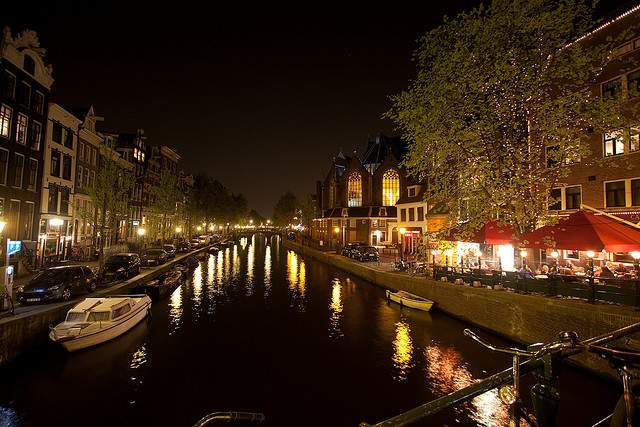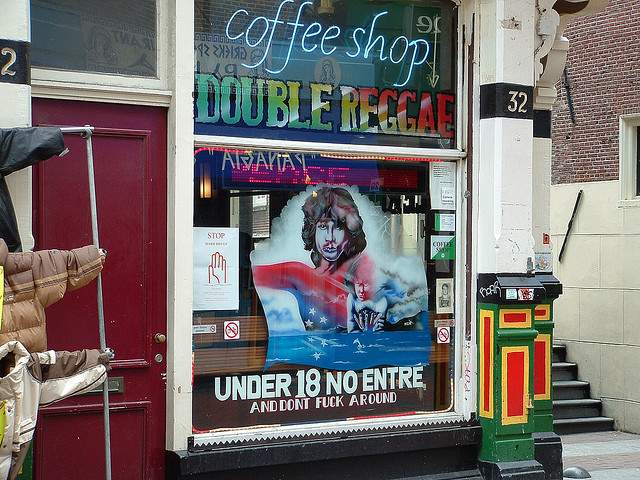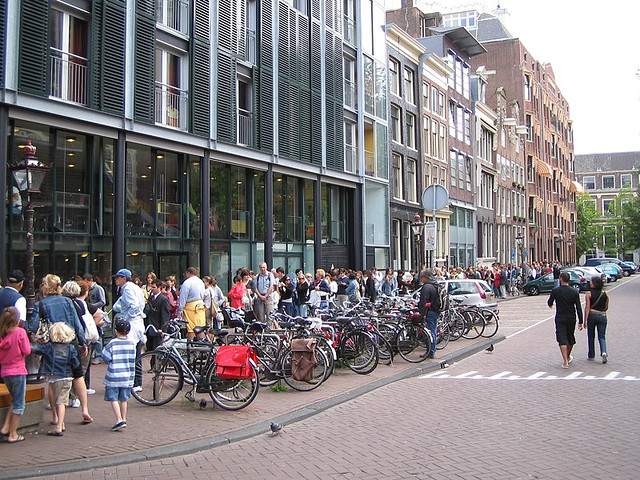Until you actually take your first trip to this stunning Dutch city, it’s easy to make some assumptions about the place based on whispers you might hear regarding its infamous Red Light District and the city’s notorious and unusual policy of allowing “soft drugs” to be used openly in its cannabis coffee shops. Well, most of the weird stuff is probably true, as we’ll get to just below, but there are many more worthwhile dimensions to this city, and it might help to understand just how things really work.
As a former resident and frequent visitor to the Dutch capital, and someone who writes and updates an Amsterdam travel guide, I take pride in trying to explain all the great reasons people should visit, and also point out some things to watch out for. This article will mostly just scratch the surface of what to see and do here, but hopefully it will also help you understand the important and controversial parts of the puzzle.
[social]
The Red Light District and sex industry
We can save the normal stuff for below, so let’s sort out this bizarre aspect to the city first. Just as it is in a few other European countries, prostitution in the Netherlands is legal, and in Amsterdam it’s also something of a tourist attraction. The Amsterdam Red Light District is by far the most famous part of the equation, but it’s definitely not the only part. Let’s run through all of it below, shall we?
Red Light District
This is the oldest and most historic part of the city, and it’s also arguably the most beautiful part, not even counting the infamous prostitutes in the windows. It’s a large area right across from the main train station and during the day it’s packed with tourists of all kinds who are roaming the area seeing what it’s all about. It may be wise to visit without children, but aside from that you may be shocked that the area is popular with young and old, male and female, and tourist groups of all kinds from around the world.
There are around 150 windows in the area, behind which you’ll usually find flirtatious girls who are trying to make a living under those flattering red lights. Along the main canals you’ll only find a few here and there, but if you turn down one of the narrow alleys you’ll be face to face with a dozen or more of them lined up in a row. With this in mind, it’s quite easy to get as big or small of a dose of this phenomenon as you want.
After around 8pm the ratio of male visitors to female visitors goes up noticeably, so it’s probably best to keep that in mind depending on your group and your goals. Prices for an unromantic 15-minute encounter with the girl of your dreams are generally €50, but you can pay more to get more time or even more unusual things thrown in. Negotiate everything first.
The city is following through on its initiative to get rid of some businesses that appear to have ties to organized crime, and they’ve bought back buildings that housed even more windows – recently leasing some of them to young fashion designers and stores. But the city has also insisted that they have no intention of plowing the prostitution thing under for good, as they recognize that it’s an important and famous part of their tourism draw.
Other sex industries in Amsterdam
Live sex shows – The Red Light District is also home to 3 or 4 live sex theaters where patrons can pay a hefty fee to watch a number of choreographed and bawdy sex acts, usually culminating in an actual couple having intercourse on stage. Each place is different and some are better for stag parties while others are better for couples and the generally curious. Do your research to pick the one for you.
Sex Clubs – None are actually in the Red Light District, but Amsterdam has around 10 sex clubs where patrons usually pay a hefty admission fee and then for overpriced drinks, as the club’s working girls flirt with them hoping to entice the customer into a full-on transaction in a private room upstairs or in back. Sounds great, I know, but you’ve also got to watch out for the ‘Taxi Scam’ on your way there, plus the ‘Champagne Hustle’ once inside. Beware.
Brothels – These places are also outside the tourist center, and often in residential neighborhoods. The Dutch call them Privehuizen (private houses) and these brothels are free to enter and totally discreet so patrons won’t ever see one another. There’s no bar or lounge, but you can get drinks, included, and the prostitutes on duty will come into your room one by one to introduce themselves before you decide which, if any, strikes your fancy. More local Dutch visit these places, and it’s all honest and straightforward, unlike the sex clubs.
Escorts – Since prostitution is actually legal, of course you’ll find escorts in Amsterdam. Recently the city has cracked down and insisted that all these businesses be properly licensed, and this has helped insure that everyone is honest and legal. There are about 10 or 12 trusted online agencies, and patrons who stick to these should have a discreet and pleasurable experience, one would hope, though it’ll cost more than the RLD window girls for sure.
Coffeeshops (cannabis coffee shops)
While it’s technically true that possession of cannabis is illegal in the Netherlands, it’s been “tolerated” for customers for more than 30 years now. In other words, there is zero risk to those who patronize the 150 or so coffee shops in Amsterdam, even if a police officer were to walk in while you were smoking.
Interestingly, there are a few laws the city and the shops themselves do enforce strictly. You must be at least 18 years old and you can only buy 5 grams per day (at any one shop). If you don’t know how much pot or hash 5 grams is, it’s a LOT, and far more than any human this side of Snoop Dogg could ever smoke in one day.
Visiting a coffeeshop
These coffeeshops (all one word, in Dutch) are sprinkled throughout the city, though they are concentrated most in the Red Light District and near other tourist areas in the city center. Most sell marijuana and hash by the gram, with a one-gram minimum. Due to recent price increases, one gram will usually cost between €8 and €12, with the strongest stuff costing the most, of course. All the cannabis in Amsterdam is of high quality, so unless you are an experienced smoker you are probably best off starting with the cheaper stuff anyway.
You can also buy pre-rolled joints for around €4 or €5, but many places only sell big joints that also include shredded tobacco, as this “spliff” style is preferred by virtually all Europeans. Some places do have pure marijuana joints though, so look around if that’s all you want.
You can also buy what they call a space cake, which many people know better as a pot brownie, though they are often in muffin, cookie, or spice cake form. These take about an hour to start affecting you, and they can be insanely strong so it’s very important to wait for a long time before considering having more. They typically cost around €5 per serving/dose, and these days can be found at almost every coffeeshop in the city.
It’s not immediately obvious, but you can buy weed at one shop and smoke it at another, as long as you buy something in the shop you are now visiting. A coffee or cappuccino will cost around €2, but you can also get juice or tea or milkshakes and even food at some places. Each shop has its own unique vibe, decoration scheme, and music theme, so it’s best to look around to find one that suits you well before committing.
Attractions worth visiting
This city is jammed with museums, but of course some are far better than others. Here’s a rundown of the famous and worthwhile Amsterdam museums, with reasons why they might be right for you.
Anne Frank House – The attic where this famous diary-writer lived for two years before being found out is part of a fairly large canal-side complex, which also includes sections on religious persecution and Nazi abuses in WWII. Sounds depressing, but people usually to love the Anne Frank House and the queues out front are almost always extremely long. Go early to avoid the crowds.
Rijksmuseum – The Amsterdam Rijksmuseum is like the Louvre of the Netherlands, but unfortunately it’s mostly closed – except for about 200 pieces in something they call The Masters collection – as part of an endless renovation to the rest of this massive museum. Rembrandt’s famous Night Watch is among those paintings still on display, but admission is the normal price even though most of this place is closed. Normally it’s the best museum in the city, by far, but during the renovation, which may be complete in 2011 or 2012, it’s borderline at best.
Van Gogh Museum – The Van Gogh Museum is just past the Rijksmuseum in the Museum Quarter, and especially now the lines tend to be much longer. It’s a modern and somewhat sterile building, and it houses Van Gogh paintings as well as those of some of his contemporaries. In spite of the obvious name recognition factor, not everyone actually likes Van Gogh’s art, so you might want to look at the posters and postcards for sale out front to be sure this place would be worth it to you.
Rembrandthouse – If you aren’t really a “museum person” and you still want on great cultural experience that is famous enough to mean something to people back home, this is the place. The Rembrandt House is the former home of this legendary artist, and it’s a small yet powerful display of Dutch history, culture, and art. It’s also cheap to enter, right in the middle of the city, and you can do it justice in under an hour.
Heineken Experience – This former brewery used to be famous for costing almost nothing to enter and then giving visitors unlimited beer for a short time at the end of the tour, but after two major renovations the Heineken Experience is nothing like that anymore. It’s now expensive and slick and still quite interesting, even though they only give each visitor a couple small glasses of beer on the way out.
Things you should do when you first arrive
>> Read the top 5 things to do in Amsterdam from Runaway Jane.
Amsterdam is a fairly compact city, and it’s easily possible to do it justice in about 3 days if you don’t linger inside all the museums and coffeeshops and whatnot. But still, there are two things you should definitely try to do as soon as possible to help you orient yourself, and both are great and cheap.
Canal cruises – If you arrive by train (from the airport or another city) you’ll exit the station to find about 8 different companies offering basically identical one-hour canal tours. They ply the same route and point out the same things. Most use recorded commentary in various languages, and if you are lucky the captain will also add some fun facts in both English and Dutch as you go along.
True, the description above doesn’t sound all that great, but honestly these quick tours are by far the best way of seeing all the most important parts of the city when you first arrive, so they are the best way of getting oriented. Weirdly, in spite of the tours all being identical, a few big companies charge around €12 per person while a few small ones charge around €7 per person, with nothing in between. Do a cheap one.
Free walking tour – For the last few years a company started in Berlin has started offering “free” walking tours of many European cities, and the Amsterdam free walking tour is typically excellent of the franchise. Not exactly “free,” the friendly and enthusiastic guides let you know at the beginning that they give the tour for tips, so they are highly motivated to make everyone happy and they usually deliver. The tour lasts around 3 hours, and starts you through the Red Light District and eventually winds its way to the Jordaan neighborhood, near the Anne Frank House. Tip your guide €5 and they are grateful and you’ve just gotten an amazing bargain yourself.
Getting into the city and getting around
If you are flying directly in you’ll be thrilled to know that getting from Schiphol Airport into the city center is cheap, fast, and easy, since there is a train station located directly below the airport. For around €4 per person, and in a bit over 20 minutes, you’ll find yourself at Centraal Station, which is the heart of the city in some ways. If you arrive by train from another city, you’re even farther ahead of the game.
Walking
If you are able bodied you’ll be able to literally walk everywhere you want to go, provided the weather cooperates, which it usually does. The main train station and the Van Gogh Museum are at opposite ends of the city center, and you could walk between them in around 30-40 minutes if you knew where you were going.
It is, however, surprisingly easy to get lost, so you’ll definitely want to get a good map upon arrival for your first visit. The city is almost completely flat and there are interesting things to see every step of the way, so it’s really just a matter of your tolerance for walking that will determine how far you can get on foot.
Public transportation
If you’ve brought heavy luggage or it’s raining hard, you’ll be thankful for the Amsterdam public transportation system.
It mostly consists of trams, but there are also buses and even a metro/subway system that doesn’t go anywhere helpful to most tourists. The system is cheap to use, but it can be intimidating and confusing, so if you plan on utilizing it you should have a look at the article linked above, which explains it all as simply as possible.
Bikes
In my article called things to know about Amsterdam, the first point I make is that bikes are everywhere, but actually renting a bike yourself as a means of getting around may not be a great idea for most people. It can be fun to rent a bike for a day and ride out to see a windmill or the countryside, but bike traffic can take some of the fun out of it, and the insane rate of bike theft plus the frequent difficulty in finding a good place to lock your bike up can detract from the experience as well.
Taxis
There are taxis in Amsterdam, of course, but they can’t be hailed on the street. You have to either call them on the phone or go to one of the taxi stands, which are conveniently located at the heart of every tourist neighborhood. They are also very expensive, so this should really be your last resort, although they might be a decent idea late at night if you don’t know your way around well.
Communicating and the language situation
If you’ve never been to northern Europe before, you’d be forgiven for assuming that you could have some major language issues while visiting. You won’t. Especially in the big cities (like Amsterdam) the locals are very proud that they speak your language (English) plus their own and maybe a few others. Unlike, say, France, you don’t even have to bother memorizing how to ask if someone speaks English. Just speak English and you’ll always be understood and your questions will be answered thoroughly back in English so good that it would put people you know back home to shame.
Knowing how to say thank you or please in Dutch is a nice touch, and you might bring a smile to a local’s face by doing it, but aside from that don’t stress about it and just assume they know English, because they do. Almost all signs are in English (as well as Dutch) so it couldn’t be easier.
Final thoughts
As mentioned in the beginning, I’ve intended to explain some of the things that might otherwise take a lot of research to uncover yourself, and hopefully this will inspire you to plan a trip soon and also research more things that specifically interest you. If you are interested in the sex stuff or the coffeeshops then they are at your fingertips, but they are also very easy to avoid if that’s your preference.
Ready to go? Book tickets to Amsterdam, find an Amsterdam hotel or read our Amsterdam travel guide.
Photos by Nicholas Doumani, Donna photo, jacobchristensen, Minimalist,



